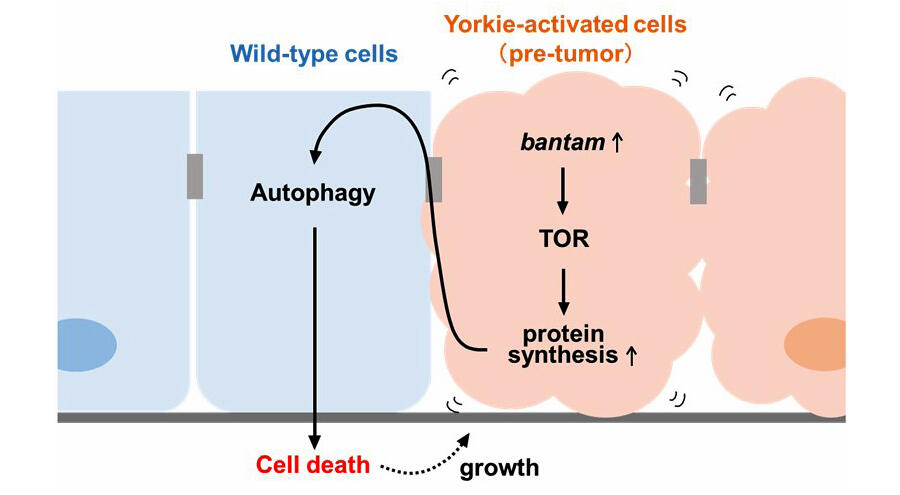Precancerous cells in tissues induce cell death in the surrounding normal cells and invade into nearby tissues. This phenomenon is called "supercompetition." However, this mechanism is poorly understood. To analyze the mechanism of supercompetition in a Drosophila model, the joint research group comprising Professor Tatsushi Igaki and Researcher Rina Nagata of the Graduate School of Biostudies, Kyoto University; Professor Shizue Ohsawa of Nagoya University; Associate Professor Shu Kondo of Tokyo University of Science; and Professor Kuniaki Saito of the National Institute of Genetics has demonstrated elevated levels of microRNA in precancerous cells, leading to TOR signal activation and increased protein synthesis, thereby inducing autophagy in surrounding normal cells and eventually causing cell death. Professor Tatsushi Igaki said, "In the future, we want to clarify the interaction among cells. The molecular groups involved in the mechanism of supercompetition are also present in humans and may help in developing novel therapeutic strategies." These findings were published online in Current Biology.

Provided by Kyoto University
Cells that are in close proximity in vivo always compare each other's "quality," and when some quality differences occur, one cell undergoes cell death and is eliminated from the tissue. Such competitive elimination of cells is termed "cell competition." In this cell competition phenomenon, the situation where precancerous cells induce cell death in the surrounding normal cells, thereby eliminating them, is called "supercompetition." This event is considered to be closely related to the development of cancer. However, the molecular mechanisms of supercompetition and their role in cannibalization are poorly understood.
Therefore, the research group focused on precancerous cells that had activated their cancer-promoting protein Yorkie (YAP in humans), which is known to induce supercompetition in humans and Drosophila. This group further analyzed the mechanism of supercompetition and its role in carcinogenesis in Drosophila. When Yorkie-activated cells (Yorkie clones) are induced in the compound eye primordium of Drosophila larvae, they invade into the nearby tissues, causing cell death of the surrounding normal cells (supercompetition). As a result, tumors are formed in the Drosophila head by the time the larvae transform into adults. This phenomenon was studied to explore the genes responsible for supercompetition.
Specifically, the research group disrupted one of the normal cells around the Yorkie clones (totaling approximately 1500 clones) in the compound eye discs of Drosophila larvae to identify suppressed tumorigenesis in adult heads. As a result, they found smaller tumors in the head due to disruption of autophagy-related genes in normal cells. The research group also found that autophagy was indeed activated in normal cells surrounding the precancerous cells. Further analysis revealed that activation of autophagy induced the expression of the cell death gene hid, thereby triggering the surrounding normal cells to undergo cell death. Further, on analyzing the events on the precancerous cell side required for autophagy activation in normal cells, it was proven that the expression of the microRNA called bantam was elevated in precancerous cells, leading to TOR signal activation. Activation of this TOR signal resulted in increased protein synthesis in preganglionic cells, leading to autophagy activation in the surrounding normal cells.
This has unprecedented implications for anti-cancer drug development. Professor Tatsushi Igaki said, "There are medicines in clinical practice that can reduce the activity of substances involved in the pathway as a whole, instead of targeting only certain components of the pathway, such as autophagy, TOR, and microRNA. Our results suggest the development of a novel class of anti-cancer drugs is possible."
This article has been translated by JST with permission from The Science News Ltd.(https://sci-news.co.jp/). Unauthorized reproduction of the article and photographs is prohibited.




